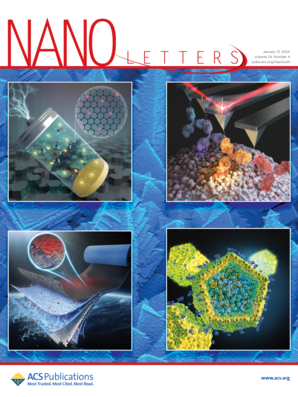层状锗硒化合物声子-玻璃电子晶体:提高热电性能的途径
IF 9.1
1区 材料科学
Q1 CHEMISTRY, MULTIDISCIPLINARY
引用次数: 0
摘要
在层状锗硒晶体中,从理论上探讨了用于增强热电优值(ZT)的“声子-玻璃电子晶体”的早期概念,其中声子输运表现出类似玻璃的行为。从头算晶格动力学和刚性电子带法在电子掺杂浓度为1020 cm-3时,在高温GeSe2相沿a轴1000 K处投射出超高ZT = 4.04。同时,低温Ge4Se9相沿a轴在600 K处达到高ZT = 2.19,电子掺杂浓度为6 × 1019 cm-3。这些最大值反映了极低的晶格热导率,分别为0.168 W m-1 K - 1 (GeSe2, 1000 K)和0.289 W m-1 K - 1 (Ge4Se9, 600 K),以及沿a轴优化载流子浓度时的高功率因数。我们的计算表明,通过在具有玻璃样声子输运的层状晶体中剪裁载流子掺杂,可以实现ZT最大化的早期概念。本文章由计算机程序翻译,如有差异,请以英文原文为准。

Layered Germanium–Selenium Compounds as Phonon–Glass Electron–Crystals: A Pathway to Enhance the Thermoelectric Performance
The early concept of a “phonon–glass electron–crystal” for enhancing the thermoelectric figure of merit (ZT) is explored theoretically in layered Ge–Se crystals, where phonon transport exhibits glass-like behavior. Ab initio lattice dynamics and the rigid electronic band method project an ultrahigh ZT = 4.04 at 1000 K along the a axis in the high-temperature GeSe2 phase at an electron doping concentration of 1020 cm–3. Meanwhile, the low-temperature Ge4Se9 phase achieves a high ZT = 2.19 at 600 K along the a axis with an electron doping concentration of 6 × 1019 cm–3. These maximal values reflect the ultralow lattice thermal conductivity, 0.168 W m–1 K–1 (GeSe2, 1000 K) and 0.289 W m–1 K–1 (Ge4Se9, 600 K), and high power factor at optimized carrier concentrations along the a axis. Our calculations indicate a promising pathway for approaching the early concept of maximizing ZT, by tailoring carrier doping in layered crystals with glass-like phononic transport.
求助全文
通过发布文献求助,成功后即可免费获取论文全文。
去求助
来源期刊

Nano Letters
工程技术-材料科学:综合
CiteScore
16.80
自引率
2.80%
发文量
1182
审稿时长
1.4 months
期刊介绍:
Nano Letters serves as a dynamic platform for promptly disseminating original results in fundamental, applied, and emerging research across all facets of nanoscience and nanotechnology. A pivotal criterion for inclusion within Nano Letters is the convergence of at least two different areas or disciplines, ensuring a rich interdisciplinary scope. The journal is dedicated to fostering exploration in diverse areas, including:
- Experimental and theoretical findings on physical, chemical, and biological phenomena at the nanoscale
- Synthesis, characterization, and processing of organic, inorganic, polymer, and hybrid nanomaterials through physical, chemical, and biological methodologies
- Modeling and simulation of synthetic, assembly, and interaction processes
- Realization of integrated nanostructures and nano-engineered devices exhibiting advanced performance
- Applications of nanoscale materials in living and environmental systems
Nano Letters is committed to advancing and showcasing groundbreaking research that intersects various domains, fostering innovation and collaboration in the ever-evolving field of nanoscience and nanotechnology.
 求助内容:
求助内容: 应助结果提醒方式:
应助结果提醒方式:


